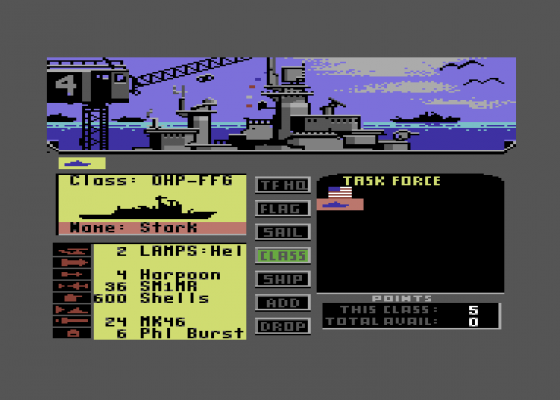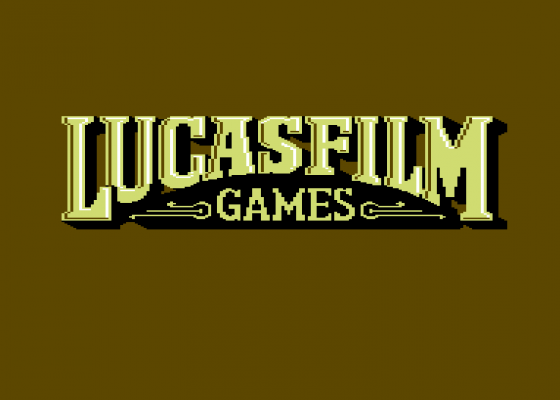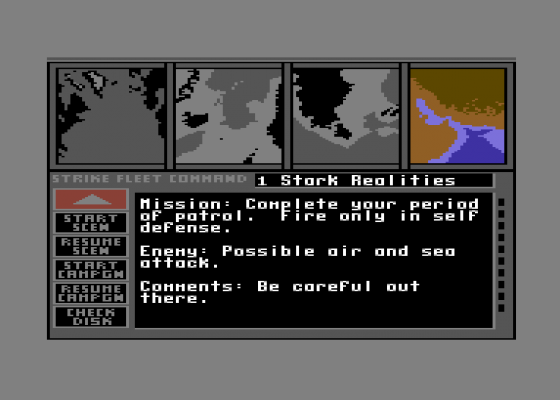
Commodore User
 1st March 1988
1st March 1988
Categories: Review: Software
Author: Ken McMahon
Publisher: Electronic Arts
Machine: Commodore 64/128
Published in Commodore User #54
Strike Fleet
Strike Fleet is the kind of ambitious multi-scenario combat sim that few software houses, with the obvious exception of MicroProse, would be ambitious enough to attempt. Perhaps not surprisingly, the game bears more than a passing resemblance to EA's PHM Pegasus hydrofoil sim which was released just before Christmas last year. Strike Fleet goes much further in virtually every respect, from the complexity and number of vessels and weapons systems you can control to the diversity of real-life scenarios in which the player can become involved.
The manual, which runs to more than 60 pages, offer a 'quick-intro' option for those who don't want to spend a weekend delving into the finer details of modern missile-based naval warfare. So those with an itchy trigger-finger can be up and running inside an hour. Strike Fleet can really be tackled on two levels: as an action arcade game, or as a fully fledged naval combat simulation as accurate as you can get on the C64. Most people will probably go for something in between. It's really as complicated as you want to make it.
The defining feature of the game, as the name suggests is that the player controls not one, but any number of vessels up to sixteen. Usually most of your time will be spent on the flagship, the other ships are looked after by the computer until you decide to bring them into use. Success depends to a large degree on sound tactics and strategy - using each of the ships to its best advantage in a particular situation and all of them working together so as to make their numbers a strength rather than a weakness.

I decided to jump in at the deep end and leave manual reading until I had been blown out of the water two or three times. The first screen displayed is the Strike Fleet Command screen which gives details of the mission briefing. You can choose from ten missions which get progressively more difficult. The objective is, obviously, to complete the scenario in the allotted time, i.e. doing what you are told. On occasions this means destroying everything in sight, but it doesn't always and if you let loose like a maniac in what is essentially a defensive role you won't be looked upon kindly.
Successful completion of scenarios gets you points and points get you stripes. If you do badly, you just don't score and if you do very badly you'll probably get court marshalled. The ultimate objective is to achieve the rank of Fleet Admiral, but it's a long way up. To get that far you have to undertake campaigns - a series of scenarios linked together. The one thing campaigns have in common is that they all include the last three, most difficult, scenarios.
In scenario 1, you control only one ship, a US frigate, defending neutral shipping in the Persian Gulf. A primarily defensive role in which you fire only if fired upon. You will be. Scenario 2 has you in command of two British Frigates chasing Argentinian subs in the South Atlantic. Don't forget that you will lose points unless they are facing in the opposite direction and heading for home when you sink them. From there you can move on to escorting reflagged tankers in the Persian Gulf with a seven ship task force and another slog-it-out in the South Atlantic. The remaining scenarios all focus on a hypothetical WWIII against the USSR in Scandinavian waters, concluding with 'mopping up' in which, though the war is virtually at an end you finish off what remains of the Soviet navy just for kicks, before the boys in suits put an end to all the fun.

I recommend you start with scenario 1 just to get accustomed to which button does what. Everything can be done with the joystick - highlighting panels on the console with the fire button, but there are key equivalents and if you can remember them they're faster. Once you have selected your ships - an easy task in this scenario as there is only one - you can set sail. You are then presented with the Command Information Centre which, in addition to giving you a large map of the area, allows you to give orders to the fleet.
Primarily the CIC is used to set courses for each of your ships. The map has a zoom facility which, as well as giving a more detailed view allows you to issue orders at task force and individual ship level. In this way you can split your fleet into several smaller task forces, merge taskforces and change flagships. From the CIC you can go to the bridge of the currently selected ship which is where the action takes place.
The bridge screen shows all navigational instrumentation, weapons systems and of course the view ahead. It's mainly a question of keeping your eye on the radar, or sonar if you're looking for subs and using the right weapons to destroy them if and when necessary. Time can be compressed up to 128 fold when nothing interesting is happening. When it does, you will get a blip on the screen and can target and view using the binocular view at the top of the screen.
It's obviously as essential to protect your ships as it is to destroy the enemy's. Incoming missile warning systems give advance notice of threats and they can be dealt with by targeting and firing AA missiles, chaff and, as a last resort, shells. It's important to detect threat at the earliest possible opportunity and you can do this to best effect by properly deploying your forces and using scout ships. You can hop about from ship to ship using the change bridge command. Very handy if the one you happen to be on is about to be sunk. Scenario 1 only gives you one ship, but you can make effective use of the two helicopters by sending them out to scout and using their radar as remote tracking stations for your long range missiles.
Where Strike Fleet leaves similar games standing is obviously in the control it gives you over everything. There are now a number of these kinds of games available when the military detail, accuracy and diversity is about as complete as you could hope for. But in most if not all of them 90 percent of the hardware is under computer control, they are automated players in the game leaving you with limited if any control over what they do. Strike Fleet gives you the opportunity, if you want it, to take control of the whole situation and so will hold a much greater appeal for the dedicated war games fan.
Other Reviews Of Strike Fleet For The Commodore 64/128
Strike Fleet (Electronic Arts)
Zzap Sizzler
Strike Fleet (Electronic Arts)
A review
Other Commodore 64/128 Game Reviews By Ken McMahon
Scores
Commodore 64/128 Version| Graphics | 70% |
| Sound | 70% |
| Toughness | 90% |
| Endurance | 80% |
| Value For Money | 70% |
| Overall | 70% |












